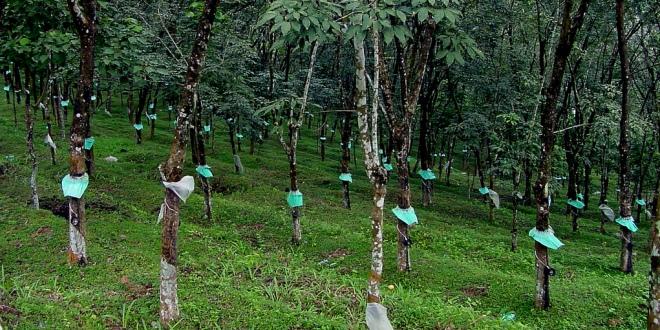Cash Crops
Common Name: Cashew
Scientific Name: Anacardium occidentale
.jpg)
Distribution: It is now distributed pantropically in hot, tropical lowlands below 1000 m.
Description: Plant is bushy, low-branched tree to 12 m in height and width; lower limbs often bend to touch the ground. Propagation by seed, grafting, layering, cuttings; Fruit production in 4-5 yr from seed, 2-3 yr from vegetative propagation. The flowers are tiny, pinkish, borne terminally on panicles. Flowers can be male, female, or perfect on the same inflorescence. The fruit is a 1 inch nut, shaped like a small boxing glove, hanging below a fleshy, swollen peduncle (receptacle) called the "cashew apple". Fruit borne singly or in small clusters. Fruit matures in 60-90 days. Apple is 2-4.5 inches in length, pear-shaped, yellow or red skin covering the fibrous, juicy, astringent yellow pulp. Nut shell contains toxic oil which must be roasted to detoxify; can cause dermatitis. Sometimes, the apple is utilized and nut thrown away. In commercial plantations, apple and nut are allowed to drop together, and nut is twisted off, leaving the apple on ground for grazing livestock. Nuts can be roasted in fire like marshmallows, where they catch flame and burn-off oils.
Cashew is adapted to warm humid tropical conditions. It can be grown in almost all types of soils from sandy to laterite and up to an elevation of 600-700 m including wastelands of low fertility. It grows and yields best in well-drained red sandy loams and light coastal sands. Heavy clay soils, poor drainage conditions, very low temperature and frost are unsuitable for the crop.
Cashew varieties
|
Varieties / hybrid / types
|
Mean yield (kg/tree/year)
|
Nature of bearing
|
|
Anakkayam-1 (BLA 139-1)
|
12.00
|
Early
|
|
Madakkathara-1 (BLA 39-4)
|
13.80
|
Early
|
|
Vridhachalam-3 (M 26/2)
|
11.68
|
Early
|
|
Kanaka (H-1598) (BLA 139-1 x H3-13)
|
12.80
|
Mid
|
|
Dhana (H-1608) (ALGD 1-1 x K 30-1)
|
10.66
|
Mid
|
|
K-22-1
|
13.20
|
Mid
|
|
Dharasree (H-3-17) (T 30 x Brazil 18)
|
15.02
|
Mid
|
|
Priyanka (H-1591) (BLA-139-1 x K30-1)
|
16.90
|
Mid
|
|
Amrutha (H-1597) (BLA-139-1 x H3-13)
|
18.35
|
Mid
|
|
Anagha (H8-1) (T 20 x K30-1)
|
13.73
|
Mid
|
|
Akshaya (H7-6) (H4-7 x K30-1)
|
11.78
|
Mid
|
|
Madakkathara-2 (NDR 2-1)
|
17.00
|
Late
|
|
Sulabha (K10-2)
|
21.90
|
Late
|
|
Damodar (H1600) (BLA 139-1 x H3-113)
|
13.36
|
Mid
|
|
Raghav (H1610) (ALGD 1-1 x K 30-1)
|
14.65
|
Mid
|
Common Name: Cotton
Scientific Name: Gossypium herbaceum
.jpg)
Description: Cotton is grown from sea level to moderate elevations not exceeding 1000 m where the climate is tropical with rainfall 500 to 750 mm. Excessive rain at any stage is harmful to the crop. It can be grown in a wide variety of soils. A deep homogeneous fertile soil is desirable.
Varieties:
Cotton varieties, spacing and duration
|
Variety
|
Spacing, cm
|
Duration, days
|
Season
|
|
MCU 5 / MCU 5 VT
|
75 x 45
|
175
|
Irrigated crop (Aug - Sep)
|
|
TCHB 213 (hybrid)
|
120 x 60
|
190
|
Irrigated crop (Aug - Sep)
|
|
Savita (hybrid)
|
90 x 60
|
165
|
Irrigated crop (Aug - Sep)
|
|
LRA 5166
|
60 x 30
|
150
|
Rain fed crop (Aug - Sep)
|
Common Name: Rubber
Scientific Name: Hevea brasiliensis

Description: Rubber can be grown from sea level up to an altitude of 500 m in areas of well distributed annual rainfall of not less than 200 cm and a warm, humid equatorial climate (21-35ºC). The soils of main rubber tracts in India, confined to a narrow belt on the west of the Western Ghats, running parallel to it for about 400 km, are mostly laterite in nature. Well-drained alluvial and red loam soils are also suitable for rubber cultivation.
Common Name: Sugarcane
Scientific Name: Saccharum officinarum
.jpg)
Description: Sugarcane grows best in the tropical regions, receiving a rainfall of 750-1200 mm. Sugarcane grows well on medium heavy soils, but can also be raised on lighter soils and heavy clays, provided there is adequate irrigation. The soils should be well drained.
The normal planting season is October-December. Delay in planting reduces cane yield. Planting should not be delayed beyond February in the plains. In hilly tracts where sugarcane is cultivated under rain fed conditions, planting should be done after abatement of heavy rains.
Reference:- KISSAN, Kerala